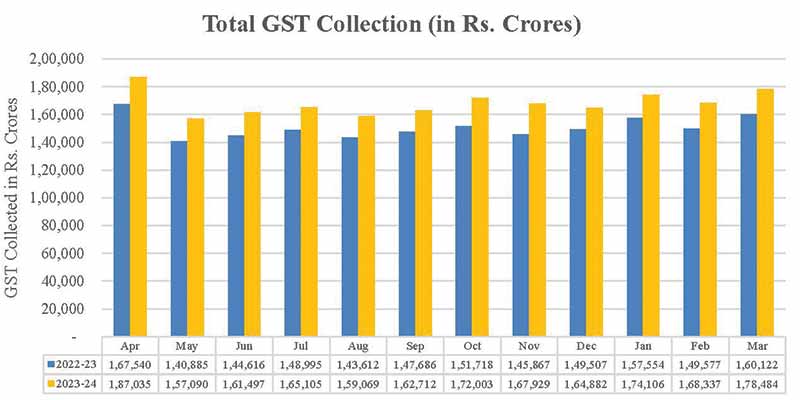- India
- Apr 02
March sees second-highest gross GST revenue of Rs 1.78 lakh crore
• Gross Good and Services Tax (GST) revenue for March 2024 witnessed the second highest collection ever at Rs 1.78 lakh crore, with a 11.5 per cent year-on-year growth.
• The highest-ever GST collection was recorded at Rs 1.87 lakh crore in April 2023.
• The gross GST collection for the last fiscal (April 2023-March 2024) stood at Rs 20.18 lakh crore, 11.7 per cent higher than the mop-up in the preceding fiscal.
• The average monthly gross collection for FY24 stood at Rs 1.68 lakh crore, exceeding Rs 1.5 lakh crore in the preceding fiscal.
• During the 2023-24 financial year, Central (GST) collection was Rs 3.76 lakh crore, State GST was Rs 4.71 lakh crore; Integrated GST was 10.27 lakh crore, including Rs 4.83 lakh crore collected on imported goods.
• Cess collection was Rs 1.44 lakh crore, including Rs 11,915 crore collected on imported goods.
Goods and Services Tax (GST)
• The introduction of the Goods and Services Tax (GST) regime in the country was a very significant step in the field of indirect tax reforms in India. By amalgamating a large number of central and state taxes into a single tax, the aim was to mitigate cascading or double taxation in a major way and pave the way for a common national market.
• Before implementation of the GST regime in the country, the issue was deliberated in detail by the empowered committee of state finance ministers, select committee of Rajya Sabha and Parliamentary Standing Committee on Finance.
• After detailed and prolonged deliberation, the Constitution (One Hundred and First Amendment) Act, after ratification by 50 per cent of the states, was assented to by the President on September 8, 2016. Thereafter, Central Goods and Services Tax (CGST) Act, Integrated Goods and Services Tax (IGST) Act, Union Territory Goods and Services Tax (UTGST) Act, and Goods and Services Tax (Compensation to States) Act were enacted in order to achieve a successful rollout of the GST regime in the country from July 1, 2017.
• With GST, India took a quantum leap towards the goal of establishing ‘one nation, one market’ by dismantling multiple taxes and unifying them into a single tax.
GST Council
• Goods and Services Tax Council is a constitutional body for making recommendations to the Union and state government on issues related to GST. The GST Council is chaired by the Union Finance Minister.
• As per Article 279A of the amended Constitution, the GST Council, which will be a joint forum of the Centre and the states, shall consist of the following members:
a) The Union finance minister (chairperson).
b) The Union minister of state in charge of revenue or finance.
c) The minister in charge of finance or taxation or any other minister nominated by each state government.
• As per Article 279A(4), the Council will make recommendations to the Union and the states on important issues related to GST, like the goods and services that may be subjected or exempted from GST, model GST Laws, principles that govern Place of Supply, threshold limits, GST rates including the floor rates with bands, special rates for raising additional resources during natural calamities/disasters, special provisions for certain states, etc.
GST rate structure
• The GST rates on goods and services were initially fitted into four slabs largely based on the pre-GST indirect tax incidence both of Centre and states, including the embedded taxes. They are:
i) 5 per cent
ii) 12 per cent
iii) 18 per cent
iv) 28 per cent.
• The GST rate structure has evolved with extensive deliberations in the GST Council and the four rate structure is a huge simplification over the multitude of taxes and cess with multiple state wise rates. GST rate structure has been further simplified after the roll out of GST.
GST compensation to states
• The Goods and Service Tax (Compensation to States) Bill, 2017 was passed by Lok Sabha on March 29, 2017 to provide for compensation to the states for the loss of revenue arising on account of implementation of the GST in pursuance of the provision of the Constitution (One Hundred and First Amendment) Act, 2016.
• Accordingly, GST compensation Act has been enacted which provides a detailed mechanism for compensation to the states for loss on account of implementation of GST. For the purpose of GST compensation to states, a cess known as Compensation Cess is being levied on luxury and demerit goods and proceeds of such cess is being credited to a separate Public Account fund known as Compensation Fund.
Manorama Yearbook app is now available on Google Play Store and iOS App Store

